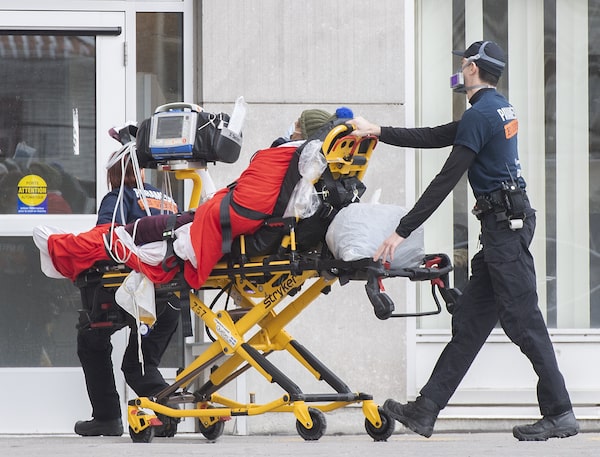
A person is taken into a hospital by paramedics in Montreal, on Dec. 29, 2021.Graham Hughes/The Canadian Press
The number of COVID-19 patients in Canadian hospitals climbed by 67 per cent over the past week, including a 9-per-cent increase in infected people in intensive care units, according to data compiled by The Globe and Mail.
The highly transmissible Omicron variant of COVID-19 has swept across Canada in little over a month. Now, as daily infections break record after record, medical professionals are nervously watching as this new uptick in people with symptoms begins to affect the health care system.
Hospitals in Quebec, Ontario and Manitoba recorded the most significant increases.
“The surge is definitely there,” said Amélie Boisclair, a critical care physician at Hôpital Pierre-Le Gardeur in Terrebonne, just outside Montreal. “Now we can only react.”
There were 2,753 COVID-19 patients in Canadian hospitals on Dec. 30, compared with 1,647 on Dec. 23, according to The Globe’s calculations, which were based on data from provincial governments. Of those patients, 507 were in intensive care as of Thursday.
In Quebec, 939 COVID-19 patients were in hospital on Dec. 30, just shy of double the previous week’s total, and up from 239 on Dec. 1. The province’s ICUs were treating 138 COVID-19 patients, compared with 91 a week prior.
Ontario counted 965 COVID-19 patients in hospital on Dec. 30, up from 440 a week prior. That included 200 COVID-19 patients in ICUs, up 18 per cent over the same period. In Manitoba, COVID-19 hospital admissions hit 147, up from 95 a week ago, and 25 of those patients were in ICUs, a 19-per-cent increase.
This wave of the pandemic has proven more difficult to forecast than the previous one, which was driven by the Delta variant. Experts are unsure how virulent Omicron is, and they don’t know to what extent it will be slowed down by vaccinations, or by natural protection from previous infections.
British Columbia’s Provincial Health Officer, Bonnie Henry, said at a Friday news conference that Quebec has been hit hard by a delayed rise in Delta-related hospitalizations, which have come at the same time Omicron cases have arrived.
Even if Omicron is less severe than previous variants, it could still damage the health care system by spreading uncontrollably and swamping hospitals with new patients. It could also spread among health care workers, forcing them to stay home from work while they isolate or quarantine. Quebec this week said it would allow some health care workers with COVID-19 to return to work, in order to prevent a staffing crisis.
“There is a lot of ‘hope for the best.’ But this is quite frustrating because my job is science,” Dr. Boisclair said. “I don’t hope; I work for those patients. They don’t get better just by chance. It is because there was a team that was there to help them.”
A study this week by Public Health Ontario said Omicron may be easier for people to recover from than Delta.
Researchers in Ontario identified 6,314 patients who were infected with Omicron between Nov. 22 and Dec. 17 and compared them with Delta patients with similar ages, genders and dates of onset. The risk of hospitalization or death was 54 per cent lower in Omicron cases than in Delta cases, the agency found, after adjusting for vaccination status and region.
“Omicron appears to be the first dominant variant to demonstrate a decline in disease severity,” the study said.
Kashif Pirzada, an emergency department physician at Humber River Hospital and Sunnybrook Hospital in Toronto, said Omicron still presents risk, even though vaccines are keeping infected people out of lethal danger and Canada’s immunization rate is among the highest in the world.
“There’s still enough unvaccinated people out there to crash the system,” Dr. Pirzada said.
So far, COVID-19 has not harmed children to the same degree as adults. But the vaccination rate for children is lower than it is for adults, and Omicron could reach young people in a way previous, less transmissible variants have not.
“It does seem to be affecting very young children more,” Dr. Pirzada said. “The ones I’ve seen need maybe a little bit of support – maybe a little bit of oxygen, some therapy, and they can go home the next day.”
“But if you multiply that across the entire population, that quickly becomes overwhelming.” Children under 5 are, for now, ineligible for vaccines.
Prior to Omicron, new daily infection statistics could be used to forecast how many people would soon be admitted to hospital, require critical care or die. But Omicron is spreading in a much different environment than its predecessors.
Canada reported an average of 25,332 new daily cases of COVID-19 between Dec. 23 and 29, according to the Public Health Agency of Canada. This marked an increase of 141 per cent compared with the previous week, the agency said. As of Dec. 29, the provinces and territories had collectively reported 34,000 cases of Omicron.
But those case numbers are not as reliable as statistics from previous waves of the pandemic, because over the past two weeks Canadian jurisdictions have restricted access to polymerase chain reaction (or PCR) COVID-19 tests. Governments have presented this as a way of relieving stress on testing labs, which can’t keep up with demand as Omicron rips through the population.
This means official case counts now exclude thousands of people who have COVID-19 symptoms but don’t qualify for publicly funded PCR testing under the new rules.
Another obstacle to predicting Omicron’s toll compared to previous waves is that the Canada is now much more heavily vaccinated than it used to be, meaning old assumptions about transmissibility may no longer apply.
By the end of August, 72.5 per cent of Canadians had received their first vaccine doses, and 65 per cent were fully vaccinated. Now, 82 per cent of people in Canada have received first doses and 76 per cent are fully vaccinated, according to PHAC. Health Canada approved Pfizer-BioNTech’s vaccine for children between ages 5 and 11 on Nov. 19, about a week before Omicron was first detected in North America.
Joseph Dahine, an intensive care physician at Cité-de-la-Santé Hospital in Laval, said hospitals are preparing in the same way they did when the pandemic started, except with depleted staff.
“We’re doing it now with the same people that are exhausted and whose morale is, I would say, at an all-time low,” he said.
With a report from the Canadian Press
Our Morning Update and Evening Update newsletters are written by Globe editors, giving you a concise summary of the day’s most important headlines. Sign up today.
 Carrie Tait
Carrie Tait